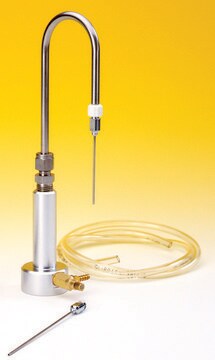22971
Six Port Mini-Vap Evaporator/Concentrator
Mini-Vap L × W 7 1/2 in. (19 cm) × 1 1/2 in. (4 cm), for use with 1-250mL containers, pkg of 1 ea
Synonym(s):
Mini Vap 6mv ea
About This Item
Recommended Products
Agency
suitable for DIN 38407-42
suitable for EPA 1633
suitable for EPA 533
suitable for EPA 537.1
suitable for EPA OTM-45
suitable for GB 31604.35-2016
suitable for ISO 25101
suitable for ISO/CEN 15968-2010
reg. compliance
suitable for FDA C-010.02
packaging
pkg of 1 ea
Mini-Vap L × W
7 1/2 in. (19 cm) × 1 1/2 in. (4 cm)
base H
3/4 in. (2 cm)
compatibility
for use with 1-250mL containers
Related Categories
General description
The 6-Port Mini-Vap (22971) concentrator/evaporator processes six miniature vials or containers at one time. Comes with six stainless steel needles, fine control needle valve, and three feet (0.9m) of plastic tubing.
The 6-Port Mini-Vap (22971) concentrator/evaporator processes six miniature vials or containers at one time. Comes with six stainless steel needles, fine control needle valve, and three feet (0.9m) of plastic tubing.
The adjustable Mini-Vap (22970) is a versatile concentrator/evaporator that can be used with a single container. The unique design allows for any size container, from the smallest vial to a 250 mL beaker.
Application
related product
Choose from one of the most recent versions:
Certificates of Analysis (COA)
Sorry, we don't have COAs for this product available online at this time.
If you need assistance, please contact Customer Support.
Already Own This Product?
Find documentation for the products that you have recently purchased in the Document Library.
Customers Also Viewed
Related Content
FAS, or 'forever chemicals,' persist in the environment and pose risks to human health. Discover our environmental monitoring tools for PFAS quantification, aiding researchers, regulators, and labs in testing for PFAS.
Our team of scientists has experience in all areas of research including Life Science, Material Science, Chemical Synthesis, Chromatography, Analytical and many others.
Contact Technical Service









